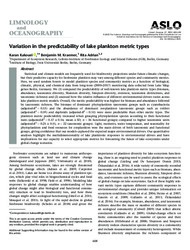Variation in the predictability of lake plankton metric types
Kakouei, Karan
Kraemer, Benjamin M.
Adrian, Rita
DOI: https://doi.org/10.1002/lno.12021
Persistent URL: http://resolver.sub.uni-goettingen.de/purl?gldocs-11858/10002
Persistent URL: http://resolver.sub.uni-goettingen.de/purl?gldocs-11858/10002
Kakouei, Karan; Kraemer, Benjamin M.; Adrian, Rita, 2022: Variation in the predictability of lake plankton metric types. In: Limnology and Oceanography, Band 67, 3: 608 - 620, DOI: 10.1002/lno.12021.
 |
Dokument öffnen: |
Statistical and climate models are frequently used for biodiversity projections under future climatic changes, but their predictive capacity for freshwater plankton may vary among different species and community metrics. Here, we used random forests to model plankton species and community metrics as a function of biological, climatic, physical, and chemical data from long‐term (2000–2017) monitoring data collected from Lake Müggelsee Berlin, Germany. We (1) compared the predictability of well‐known lake plankton metric types (biomass, abundance, taxonomic diversity, Shannon diversity, Simpson diversity, evenness, taxonomic distinctness, and taxonomic richness) and (2) assessed how the relative influence of different environmental drivers varies across lake plankton metric models. Overall, the metric predictability was highest for biomass and abundance followed by taxonomic richness. The biomass of dominant phytoplankton taxonomic groups such as cyanobacteria (adjusted‐R2 = 0.53) and the abundance of dominant zooplankton taxonomic groups such as rotifers (adjusted‐R2 = 0.59) and daphnids (adjusted‐R2 = 0.51) were more predictable than other metric types. The plankton metric predictability increased when grouping phytoplankton species according to their functional traits (adjusted‐R2 = 0.37 ± 0.14, mean ± SD, n = 36 functional groups) compared to higher taxonomic units (adjusted‐R2 = 0.25 ± 0.15, n = 22 taxonomic groups). Light, nutrients, water temperature, and seasonality for phytoplankton and food resources for zooplankton were the main drivers of both taxonomic and functional groups, giving confidence that our models captured the expected major environmental drivers. Our quantitative analyses highlight the multidimensionality of lake planktonic responses to environmental drivers and have implications for our capacity to select appropriate metrics for forecasting the future of lake ecosystems under global change scenarios.
Statistik:
ZugriffsstatistikSammlung:
This is an open access article under the terms of the Creative Commons Attribution License, which permits use, distribution and reproduction in any medium, provided the original work is properly cited.

